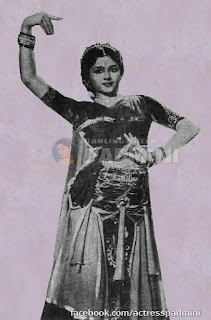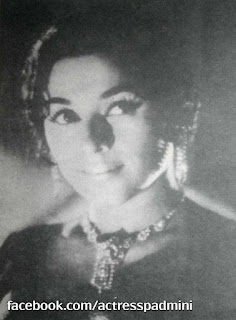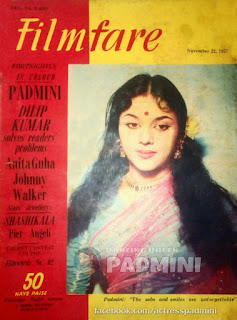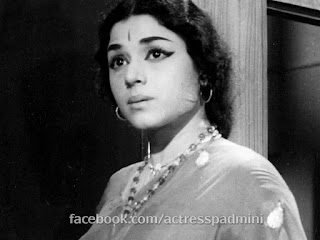In this article (from filmfare oct 11 1957), the travancore sisters Padmini and Ragini writes about their impression of their forign tour to the 6th international youth festival, Moscow in 1957.
Tonight we emplaned for Europe at Bombay. It was a relief to board the plane at last, after wishing innumerable friends “Good Bye” at the airport, their cries of ‘Bon Voyage’ still ringing in our ears.
We flew over Venice early the next morning, and at 8:40 a.m. we were in Zürich. At the airport we were surrounded by a number of girls who had been waiting for us. We got busy signing autographs. “Are you twins?” we are asked frequently.
After a 4 hour stay in Zürich, we flew to Paris.
Paris was like dreamland! “The first thing to do is to go shopping and buy perfumes!” Pappi said, and off we went. We bought several kinds of perfumes in a matter of minutes. It was pity we couldn’t see very much of Paris as we were there for only two hours. But in that short time Ragini shot many street scenes with her 16 mm. movie camera.
We changed to Czech airways and went on to Prague. We were there only an hour. Prague looks different from other European cities we have seen. So do its people. The woman are sturdy and hospitable.
On the last lap of our journey to Moscow we travelled by jet plane, at six hundred miles an hour. There was a large crowd at the airport waiting to welcome us with flowers, garlands, smile and warm hospitably! We arrived at night, and it was a refreshing drive from the airport to the Hotel Ukrania. It was very cold. We passed the Kremlin and saw the huge red star at its top like an enormous jewel suspended in the black velvet sky.
The hotel Ukrania is one of the biggest in Moscow. Our rooms were in the twenty fourth floor!
Sunday, july 28:
The youth festival opened today. It was an unforgettable sight. We didn’t know whether to feast our eyes on the vast spectacle or film it with our movie camera.
The delegates of different country went in procession to the stadium where the festival was held. We were in the leading jeep, holding India’s flag. It was a huge heavy flag and took our combined strength to keep it waving aloft. Pappi was too thrilled to feel tired!
 |
Padmini and Ragini hold aloft the Indian national flag
in the stadium where youth festival is held |
The pavements were packed with people. They occupied vantage points on the top of houses and trees. They filled the balconies. Gaily dressed people from the provinces lined the street.
They threw flowers and garlands at us and pinned souvenirs on our blouses. They grabbed our hands and shook them. Cries of “hindi-roosi Bhai-bhai” and “Drushba Mir” (“peace and friendship”) rent the air. When we got back to our hotel in the evening, our hands were sore with bruises and cuts.
We walked the last two miles to the stadium, bearing our heavy tricolour. It was an unimaginable crowd. The delicates alone, from all over the country, numbered more than thirty-five thousand. Bulganin and Khrushchev were there.
The delegates from forty-eight participating nations circled the pavilion in an impressive parade.
“oh,look! There’s Raju Bhaiya (Raj kapoor) with his camera filming everything!” said Padmini. How popular he is in Russia. Wherever we go, people ask us! “You are from india? Do you know Pandit Nehru? Do you know Raj Kapoor?” In Russia they are the best known and best loved indian personalities.
After the opening ceremony, we went out of the stadium accompanied by Raju Bhaiya. People recognized him at once. They mobbed him everywhere, pushed us aside. At one place the throng was so big and unmanageable that we were bruised. We were pushed away while he kept calling out to us, but we just couldn’t get back to him in that milling crowd. A girl fainted. But it wasn’t because of the crowd. “Raj Kapoor!” She exclaimed, taking one long look at him-- then passed out.
We were taken back to the pavilion in an ambulance. Raj was there already, looking untidy, his clothes torn, sitting in one of the tiers of seats. Here, too, was a crowd round him. We joined him there, and in tier above ours were Bulganin and Khrushchev.
Ten thousand students of moscow university put over a remarkable performance. They danced to specially recorded music, and changed costume for each item within seconds. They wore dresses of different colours, and by merely tugging a tiny cord the top dress would fall away, revealing the one beneath it. Last of all was the white one, when they formed themselves in the shape of doves (as the symbol of peace). The entire act was performed with precision and was most impressive.
There were also the uzbek folk dances, performed by men and women in picturesque costumes of red, white and blue. They were the most colourful dances we have ever seen.
Then there was a performance of the ballet type in which the dancers were dressed in flowing robes of white nylon, with flaming torches in their hands. They were so light on their feet that they created the impression not of human being dancing, but of the wind in its movements become visible to our eyes. It was a performance of breath taking beauty. If Ragini had met the man who had visualised and directed the performance, she said she would have given him anything-except her heart!
The show went on for more than eight hours, but at the end of it we were not tired. On the contrary, we were exhilarated by it. Night fell and myriads of lights sprang up all over the stadium.
At last, we all got together Prithviraj and his wife, Raj, Mother and both of us-and we went back to the hotel. Thus ended the first day of the festival. We were so excited we couldn’t sleep that night!
Monday, July 29:
Today, we gave our first dance performance in moscow. Held in the open air at the agricultural exhibition at 5-30 pm, it was a great success. We had to repeat every item twice, because at the end of each the audience would start clapping in rhythm and would not stop until we gave an encore.
At the end of the show we remained on the stage for fifteen minutes while the audience threw bouquets, flowers and coloured streamers at us until we were in a see of them.
Scores of photographers and movie cameraman photographed and filmed our dances,which were also televised in Russia.
Tuesday, July 30:
We gave a dance recital again today-at the Red army theatre. For each item the ovation was so thunderous and so prolonged that we had to repeat it at least five times.
Members of the Indian delegation to the youth festival were pleased with our performance. “Apne Bharat ka naam rakha!” they said to us.
Prem Dhawan, a member of the Indian delegation had a Punjabi folk song which he wanted to put over. So we composed a dance for it. Ragini was the sardarji in the dance and Pappi was the wife. The dance went over very well. Everybody thought Ragini was a boy!
Here we had another experience of a mass demonstration of affection. If you are their idol, people encircle you and throw you up in the air, catch you as you fall and throw you up again. Raj kapoor was thrown up several times. They wanted to throw up us, too, but Mamma wouldn’t have it because we were wearing saris!
 |
Photograph taken after the International dance competition. From left:
A korean Ballerina, member of jury, Padmini, another member of jury,
Raj Kapoor, Ragini and a South American dancer |
Wednesday, July 31:
There was a party at Mosfilm studios for the indian contingent today. Here we met, for the first time, the famous Uzbek dancer Tamara Khanoun. She must be about fifty, but her dancing has the vigour of a youthful performer. Her little grand daughter became a great friend of Ragini’s. She used to call Tamara “Mummy”.
Tamara Khanoun performed Chinese, Hungarian and Ukrainian dances. When we met her after the show, She invited us to dinner.
Thursday, August 1:
The International Dance competition in the classical style was held today at Coloum’s Hall. Three thousand dancers from all over the world participated in it. The Chinese gave a very good performance. The members of the jury looked solemn as they watched the performance and made notes on it. Although it was not a public show, there were cries of “Encore” for our dance.
The result of the competition will be announced in a few day’s time.
Friday, August 2:
Today we repeated the performance we gave at the International Dance Competition for a colour newsreel.
Every room in the hotel has a TV set. We saw on our set foreign films with Russian subtitles.
Sunday, August 4:
We went again to Coloum’s hall to participate in the International folk dance competition. We then went to the television studio and repeated our dances before the television cameras for the benefit of TV viewers throughout Russia. We performed a third time,at another hall, for the journalists.
Monday, August 5:
Tonight we attended the Kremlin Ball. It was a glittering gathering of more than two thousand guests from many countries, and they came in their respective national dresses. Everyone joined in the singing and dancing, and the high point of the evening was the exhibition of fireworks which filled the night sky with multi colored flames.
During the entire period of the youth festival, Moscow throbbed with life. Its streets were gay with singing and dancing. At every street corner there was a stage, and whoever had any talent sang and danced and acted for the populace. Whenever we went out, shopping or for a walk, people recognized us and surrounded us, and asked us to sing and dance for them right there in the street!
While we danced, they sang two indian songs with Russian words. Both are very popular in Russia-”Awara hoon” from “Awara” and “Ichak Dana” from “Shree 420”, both sung by Raj in those films. They gave us ice cream (how much ice cream we ate!) and sweets, trinkets and other souvenirs.
They sent up a huge white balloon shaped like a dove into the sky. We saw it going higher and higher all day, and then disappear.
Tuesday, August 6:
We went to the Kukul theatre (“kukul” means “puppet”) to see a puppet dance. Dressed in the costumes of different nations, the puppets were very colourful and were manipulated from behind a curtain. During the interval we were invited backstage and shown how the puppets were operated. Balraj Sahni was also at the show.
The next day we bought a set of puppets at Ghoom, Moscow’s biggest shopping centre.
Within a week of our stay in Moscow we had three pupils who came to us regularly to learn Indian dancing. One was a Korean ballerina, and the other two were Russians. We lent them our costumes and they practised in our room while our tape-recorder played Indian music. We were the cause of much disturbance to Prithvirajji, who occupied the room beneath ours!
Wednesday, August 7:
We attended an evening function organised by the Indian delegates to the youth festival at the Czechokwi hall. It was a very cold night.
Thursday, August 8:
The Bengalis who were in moscow held a “Tagore Evening”. That morning we were given one of Tagore’s poems and asked to compose a dance from it. We performed the dance at the function. The gathering included several Russians who could speak Bengali. We also met a Russian student there who spoke to us in Tamil!
Friday, August 9:
We learned that we had won medals and diplomas at the International dance competition held a week earlier. It was wonderful. Our colleagues congratulated us and threw a party in our honour. In the evening, the winners performed their best item at Coloum’s hall for television. We received our prizes there and the medals were pinned on us by the president of the jury.
Saturday, August 10:
We went to the Bolshoi theatre (“Bolshoi” means “big”) to see the famous ballerina Galina Ulanova in the immortal ballet “Giselle”. The Bolshoi is one of the biggest theatres in Russia and is decorated in crimson, velvet and gold. Ulanova, who is forty- seven but looks eighteen on the stage, was giving one of her last performances and we were fortunate to see her in that ballet.
Sunday, August 11:
It is the last day of the youth festival. In a final burst of enthusiasm, people sang and danced in the streets. There were performances on street corner stages and films were shown throughout the day and night. All day long, all night long, the city was alive with rejoicing.
Monday, August 12:
Today was Padmini’s first day at Mosfilms studios for the Indo-Russian co-production “Pardesi”. Balraj Sahni and Oleg Streezhenov were also on the set. Pappi performed a dance composed and directed by Ragini.
In Moscow women do almost everything. There are women truck-drivers, engine-drivers, taxi-drivers, etc. We saw women climbing tall ladders with buckets of water to clean the windows on the twentieth floor of our hotel. At the studio, too, women do important jobs. There are women assistant-directors, and women are also in charge of editing, lights and sound.
Thursday, August 15:
Our Independence day. There was a function at the Indian embassy, where a flag hoisting ceremony was held, followed by a variety entertainment. Prithvirajji did an item, and we sang songs. Mrs.K. P. S. Menon, wife of the Indian ambassador in Moscow, was the hostess.
The Malayalam new year was also celebrated there on Saturday, August 17.
We went twice for dinner at Tamara Khanum’s house. We taught her indian dances and She taught us Uzbek dances. She gave us Uzbek costumes stitched by herself. Day and night she worked on them, so as to have them ready before we left Moscow. She also gave us records of Uzbek music to bring back with us.
 |
Padmini in Uzbek costume stitched specially for Travancore sisters
by famous Russian dancer Tamara Khanum. On the shelf are the medals
and diplomas she and Ragini won at international youth festival |
We had been eating boiled food and we were tired of it, but at Tamara’s house we were very happy to find that uzbek food is spiced. We took handfuls of chillies from her house to eat with our food at the hotel.
Indeed we were so tired of boiled food that we thought we must have a bottle of pickle. In the end, when we could stand it no longer, we put in a long distance telephone call to our home in Madras and asked for some pickle to be send to us immediately!
Four Russian ballerinas, Natasha, Neena, Gaalia and Olya, have been coming to us to learn indian dancing. They call us “Ragina” and “Padmina” because the name of Russian girls end with an “a”.
 |
Ragini in Uzbek costume strikes a pose from
Uzbek folk dance which she learnt from Tamara Khanum |
Sunday, August 25:
We went to the Culturi park in Moscow. A river flows through the park, and people can go there by boat. There are permanent stages here where singing is taught. There was a famous chess-player at the park. He had a chess-board before him and he was surrounded by about five hundred people. He was playing against all of them.
People were going for stunt flights in a plane. Pappi also went. She was frightened when the plane began to loop the loop, and when it flew upside down, she screamed and screamed, crying for help in Malayalam! Ragini enjoyed the sight from below and filmed Pappi’s flight with her movie camera!
There was a man in the park who imitated animal cries. Ragini went up to him and showed him what she could do. She imitated a baby crying. She is expert at it. In Madras, whenever a film in which Pappi works require the sound of a baby crying, Ragini goes along to do the “playback”.
Friday, August 30:
Our last day in Moscow. All the members of the “Pardesi” unit came to the airport to bid us farewell. Our new friends were in tears. Naadia, a sweet young girl who operated an elevator at our hotel and has become our friend, was in tears, too. To all of them we said, “Das-wedania” (Good bye).
Our journey back was via Riga, Stockholm, Copenhagen and London. At everyone of these places we bought whatever took our fancy and boarded the plane loaded with packages. We had so many packages when we got off the plane at Bombay that we left behind a little bag which contained our jewellery. Not until we reached the hotel, did we miss it. Ragini raced back to the airport, where fortunately the authorities had taken charge of it. They sent her back escorted by two policemen.
We were away for a month and ten days. During that time both of us put on fives pounds in weight.
We are going back to Moscow in March next year to work in a film called “The Family of Nations”, based on the youth festival. Two artists from each country will work in the film and we shall represent India.
So when we said “Daswedania” to our friends at the Moscow airport, it was not “Good-bye” but “Au-Revoir".













